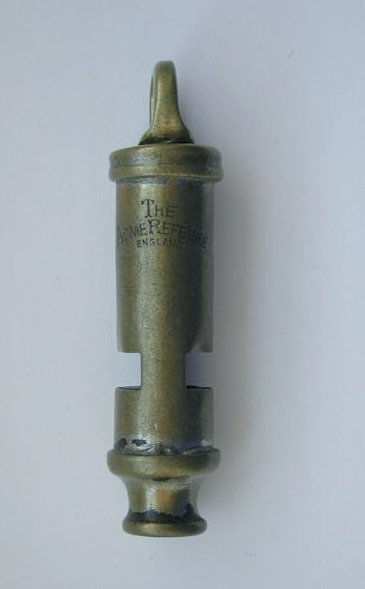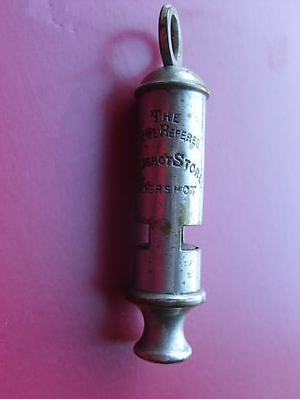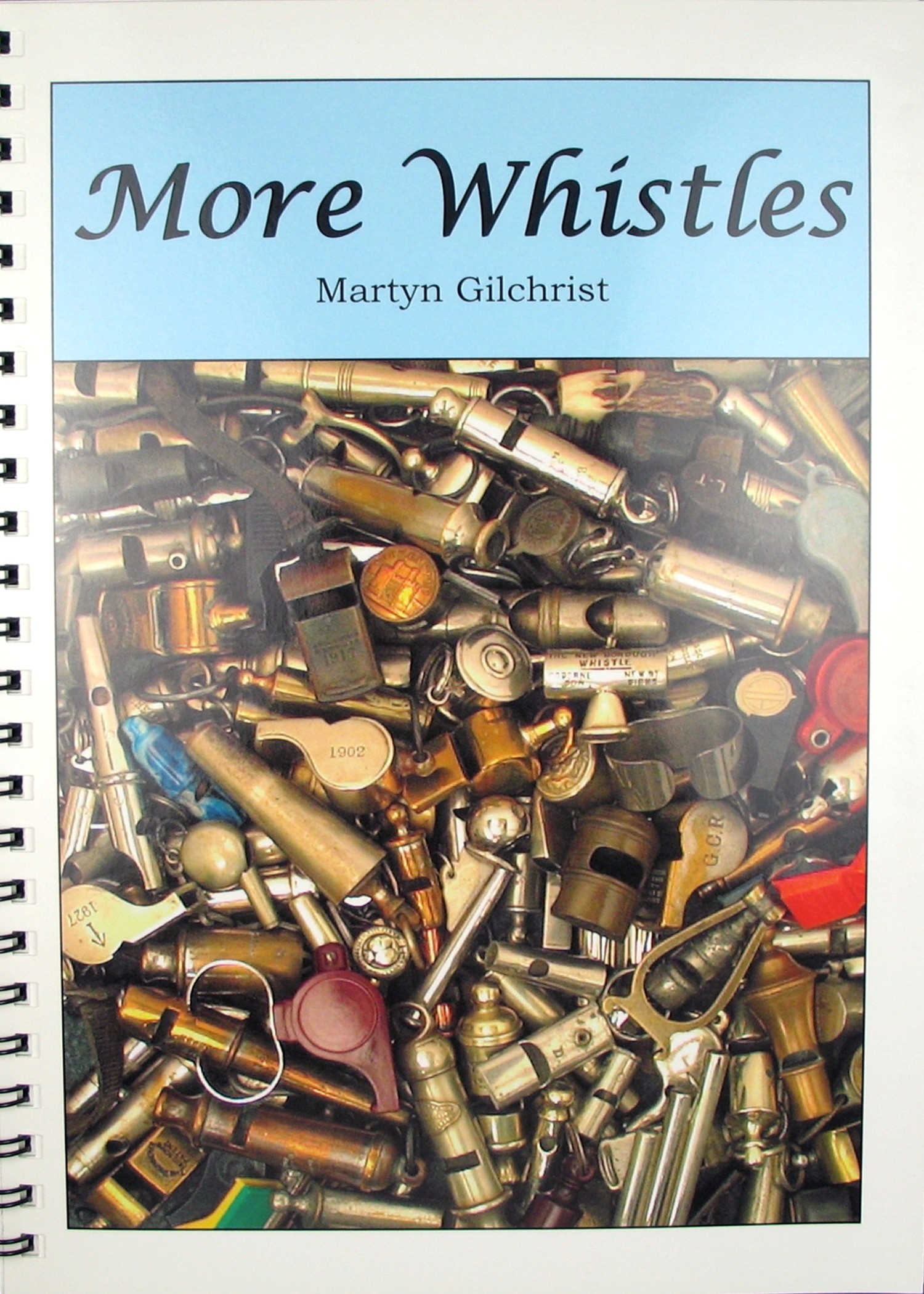Spotlight > Whistle Categories > Sports> 124
Whistory
The definition of Referee is: ‘one to whom something is referred, especially for decision or settlement; arbitrator’.
Most often when it comes to referees, we think of sports events and indeed all whistles dedicated to referee’s use, appear to be logically so.
Of course, as in any subsection of whistle use, any sort of whistle or any stamped whistle can be used. However, for our purposes, we will be focusing on vintage metal whistles, stamped with the word REFEREE on them. As we put this article together, we start with 12 whistles and an additional list of other known whistle stamps.
We find them in only two whistle designs, escargots and tube shaped. What are the characteristics we find along the way ?
Interestingly, tube shaped models are manufactured almost exclusively by one company – Hudson’s of the UK ( the exceptions being Alfred DeCourcy, albeit ‘late in the game’ and possibly Yates ) Another observation is that these ( Hudson ) are usually model 48, which is a smaller than usual size, a ‘mid size’ whistle. On page 46 of CPWs there are 5 tube shaped whistles pictured. The John Piggot League whistle is described as a fore runner of the Acme Referee. The Garstin’s referee is ‘standard’ size.
Whistology
| Category | Tube Escargot |
| Class | Hudson DeCourcy Yates ? unknown ( USA ) |
| Type | Referee |
Conflicting stories abound as to earliest uses of the whistle in a sports events.
First there is a lapse whether the earliest recorded use of a whistle in a sporting event was an escargot or a tube-shaped whistle.
Joseph Hudson is credited with ‘designing, inventing, coming up with’ a whistle for a football event without any proof and then repeated in various forms ad infinitum. It appears to snowball from there. ( A side effect of the internet is that once something is posted, it is repeated without verification till it has the appearance of fact ).
The only date of consistency on the net is the game of 1878 at Nottingham Forest and a reference to a whistle being used there, however sporting events had been in played for many years prior. Indeed dates of 1860, 1868, and 1878 abound on the net for this event as a ‘significant’ date in sporting/whistle history.
For the record, the earliest escargot whistles had been in use for years as button whistles, perhaps decades by 1878. Tube shaped whistles of Hudson’s ‘design’ had been in use for a decade also – Stevens and Sons had made ‘dissonant’ type tube shaped whistles with two windows for a decade prior to Hudson’s ‘invention’. He did not invent it, but he did win a contest to sell his model to the metropolitan Police Dept in 1883.
Most descriptions of Joseph Hudson’s early years are fanciful at best, one having him as a tool maker at 12 years old. His years of apprenticeship and training at Bent and Parker ( a whistle maker ) are completely ignored. The dates surrounding the name Thunderer and Acme registration are similarly completely at odds with actual records.
What are we left with ?? Disinformation.
No description of the type of whistle used at the earliest known sporting event utilizing a whistle is recorded.
No known whistle maker is verified to credit whatever whistle was used.
With that in mind, we focus on stamped REFEREE whistles. The earliest found whistle is a Referee escargot which was a Hudson Registered Design 230905 1894 hollow knop top found in four sizes. This was indeed by Joseph Hudson 5 years after that 1878 event. Pictured is the second from the smallest size and clearly stamped REFEREE. Side by side with the Acme REFEREE dated C.1886 to 1889.




From these early whistles we move to a comparison study of like whistles, firstly tube shaped. The first is unusual in that the pillar top was usually reserved for scout whistles. The Acme is steel and brass. The REFEREE patent for 1898. The Young and Co. is a distributer.
Pillar top – circa 1920
Steel and brass – circa 1920
Referee patent — circa 1898 – 1907
Young and Co. – circa 1885 – 1899
The Acme patent – 1886 — 1889

No other escargots are found until the USA models appear. They are all models having interlocking teeth. ( see SPOTLIGHT # 10 ) four models are known.
- REFEREE circa 1916 – 1922 upside down stamp 7 teeth per side
- REFEREE circa 1923 – 1927 with 3 interlocking teeth, large
- REFEREE circa 1923 – 1927 with 3 interlocking teeth, mid size
- REFEREE circa 1927 – 1928 with 1 interlocking tooth, large


Honorable mention listed in CPWs:
Referee patent John Shillock Birmingham ( no picture )
Referee ( DeCourcy esc, tube ?? ) – not pictured
Abbey Referee ( Hudson esc or tube ?? ) – not pictured
Referee A.W. Shillock Birmingham ( Hudson ) – pictured
The Acme Referee England flat top – pictured
( The Acme referee trademark 1908 ( to 1939 )
Grasshopper referee – pictured
The Acme referee Aldershot Store – pictured
The Criterion Referee ( possibly Yates )
Garstin’s Referee Hudson

credit needed

photo courtesy of Leif Bailey

contributed photo

credit needed

credit needed

photo courtesy submission

DeCourcy REFEREE
end notes. Various quotes with spurious information:
“Joseph Hudson, of Birmingham in England, came up with the first whistle ever which was used in a match by a football referee in 1868 ( no proof offered ). The first game ever credited with the use of a whistle was a game at Nottingham Forest. –—- difficult to prove as he worked by his own account till he was 20 at Bent and Parker, leaving in 1870, ( 2 years later ).”
“Joseph Hudson set up J Hudson & Co in Birmingham, UK in 1870 ( actually set up in 1882-3 ). With his younger brother James, he designed the ‘Acme City’ brass whistle. This became the first referee whistle ( not true ) used at association football matches during the 1878–79 Football Association Cup match between Nottingham Forest and Sheffield. –—- difficulty is the Acme City was registered in 1907”
“In 1860 tool maker Joseph Hudson (1848–1930) had an accident with a violin which he dropped ( fable ) . He became fascinated with the perfect sound created when the bridge and string broke. Determined to replicate the sound he developed a pea whistle ( falacious ) . Hudson started to manufacture the ACME Whistle Company (based at Mills Munitions Factory, Birmingham) in the 1870s. ( falacious )”
“Enter John ( Joseph ) Hudson, who invented the first practical whistle for football ( not verified ). It was first used in 1868 ( spurious ) in a match at Nottingham Forest, and it quickly caught on. By 1884, Hudson had perfected his design, producing the first pea whistle, which he named ( fallacious ) the “Acme Thunderer,” a brand that still exists today.”
“Hudson entered a competition held by the Metropolitan police force in London in 1883 to design a better way of attracting people’s attention. He won a contract to supply the police with their new devices, a small but loud ‘whistle’. Prior to this time the police force had to rely on hand rattles and whistles were only thought of as musical instruments or toys ( fallacious ). His whistle is still used by the force and many others worldwide.”
Conclusions:
Stamped referee whistles are uncommon outside of Hudson whistles, which were wise to target this type of whistle use. Credited with the first is tenuous at best. Surprisingly the UK dominated this stamp, with the USA trailing in the late teens to early 20s.
TWG
Posted July 8, 2021
Bibliography:
Dictionary.com
Sportskeeda – https://www.sportskeeda.com/football/a-short-history-of-the-football-referees-whistle
Wikipedia – https://en.wikipedia.org/wiki/Whistle
History of Soccer Boots ( blog ) – http://fitba2014.blogspot.com/2014/06/a-short-history-of-referees-whistle.html
A short history of the football referee’s whistle
Quora – https://www.quora.com/What-did-referees-use-before-whistles
Officiating Forum – https://forum.officiating.com/basketball/99378-whistle-history.html










